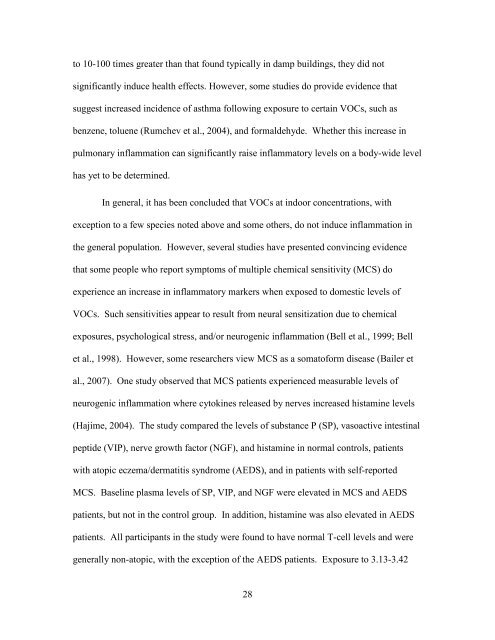INDUCTION OF DEPRESSION BY EXPOSURE TO DAMP ...
INDUCTION OF DEPRESSION BY EXPOSURE TO DAMP ...
INDUCTION OF DEPRESSION BY EXPOSURE TO DAMP ...
Create successful ePaper yourself
Turn your PDF publications into a flip-book with our unique Google optimized e-Paper software.
to 10-100 times greater than that found typically in damp buildings, they did not<br />
significantly induce health effects. However, some studies do provide evidence that<br />
suggest increased incidence of asthma following exposure to certain VOCs, such as<br />
benzene, toluene (Rumchev et al., 2004), and formaldehyde. Whether this increase in<br />
pulmonary inflammation can significantly raise inflammatory levels on a body-wide level<br />
has yet to be determined.<br />
In general, it has been concluded that VOCs at indoor concentrations, with<br />
exception to a few species noted above and some others, do not induce inflammation in<br />
the general population. However, several studies have presented convincing evidence<br />
that some people who report symptoms of multiple chemical sensitivity (MCS) do<br />
experience an increase in inflammatory markers when exposed to domestic levels of<br />
VOCs. Such sensitivities appear to result from neural sensitization due to chemical<br />
exposures, psychological stress, and/or neurogenic inflammation (Bell et al., 1999; Bell<br />
et al., 1998). However, some researchers view MCS as a somatoform disease (Bailer et<br />
al., 2007). One study observed that MCS patients experienced measurable levels of<br />
neurogenic inflammation where cytokines released by nerves increased histamine levels<br />
(Hajime, 2004). The study compared the levels of substance P (SP), vasoactive intestinal<br />
peptide (VIP), nerve growth factor (NGF), and histamine in normal controls, patients<br />
with atopic eczema/dermatitis syndrome (AEDS), and in patients with self-reported<br />
MCS. Baseline plasma levels of SP, VIP, and NGF were elevated in MCS and AEDS<br />
patients, but not in the control group. In addition, histamine was also elevated in AEDS<br />
patients. All participants in the study were found to have normal T-cell levels and were<br />
generally non-atopic, with the exception of the AEDS patients. Exposure to 3.13-3.42<br />
28


